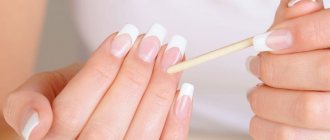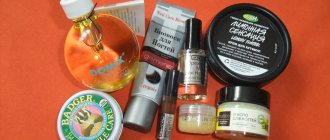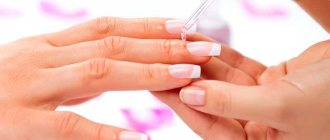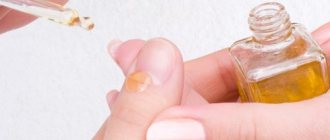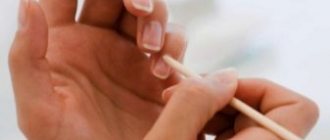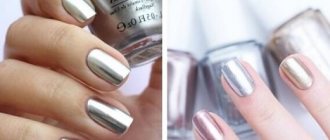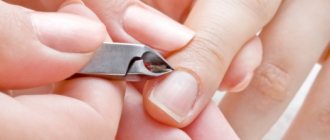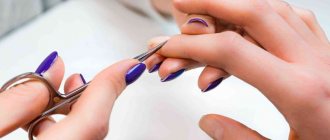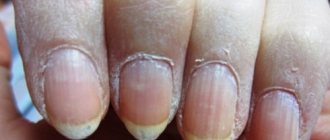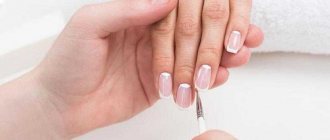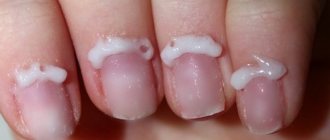08/13/2017 · What a master needs · One comment
When performing a European manicure, masters use various means to help quickly and painlessly remove the cuticle without the intervention of cutting tools. One of the most effective means in the fight for well-groomed hands is pumice for cuticles.
Read: the best cuticle softeners
Our editor's solo project
When did Kurt Russell's heroes stop being heroes? www.bunnycup.ru
Benefits of pumice for cuticles
The skin cushion, which is called the cuticle, performs a protective function, preventing infection and fungus from entering the base of the nail plate. However, modern canons of beauty dictate to us that dead skin must be removed in order to achieve a beautiful and neat manicure.
With traditional trimming techniques for processing cuticles, the risk of wounds and infection is very high. Especially if the master does not have enough experience and approaches the issue of sterilizing instruments irresponsibly. That is why it is recommended to use an unedged or European manicure, during which the cuticle is either simply pushed back to the base of the nail or removed using special liquids, a milling cutter or pumice.
The use of pumice has been known to mankind for many centuries. This natural material is used not only to treat the cuticle area, but also to soften the skin of the feet.
Pumice contains aluminum oxide with porcelain particles, which makes its structure porous and hard. Due to these properties, pumice does an excellent job of removing dead skin without injuring it or causing allergic reactions, unlike chemical removers. In addition, this material is durable and can be used for several years .
Trending: manicure with kamifubics at home
We remove the cuticle with a special pumice stone
The cuticle protects the nail from infections and fungi, so it is necessary to pay attention to its health. When this skin fold is damaged, the risk of developing diseases increases. When cutting a manicure, it is easy to injure the cuticle due to inexperience or haste.
Therefore, it is better to switch to European manicure, which does not use a traumatic method of skin removal. Here pumice is used for the cuticle. This method of processing is preferable to cutting or pushing back.
And this is due not only to a lower risk of injury and disruption of the integrity of the skin fold. The fact is that when the cuticle is damaged or pushed back, a large number of pathogenic bacteria accumulate under it. The use of chemicals is also not always possible, because...
they can cause allergic reactions or injure the nail plate. Only pumice for treating cuticles has no contraindications.
Advantages and disadvantages
Pumice has a porous structure and consists of aluminum oxide pressed with small particles of porcelain. Thanks to its shape and the materials used, it cannot damage nails or injure the skin. This remedy has been known for hundreds of years and has been used since ancient times. Positive aspects of using pumice:
- prevention of burrs;
- effectively removes dead cells;
- has a natural composition;
- does not cause harm to nearby healthy tissues, does not injure the skin and nail plates;
- durability, can be used tens and hundreds of times;
- safe;
- an easy-to-use tool that does not require special skills;
- It is compact, you can take it with you, it does not take up much space in your cosmetic bag.
Does this product have any disadvantages? Perhaps the only thing is that if you have skin diseases or injured skin, you shouldn’t use it, because the situation can only get worse. Many people do not like the fact that the procedure is quite lengthy. Processing each finger takes quite a long time.
Mode of application
Usually, pumice is slightly moistened before use, so it moves softer and smoother without injuring adjacent tissues. But, if you have certain skills, then you can use it “dry”.
Before processing, you need to wash your hands well and disinfect the instruments that will be used during the procedure. It is good to treat wet fingers with a scrub, as it softens the skin and removes hangnails. Small leathery growths can be easily removed with this product; there is no need to use pliers.
- At the beginning of the procedure, you need to make a hand bath to steam the skin and soften it. It is advisable to add a softening composition and flavorings to the water. If there is no special product, then you can use what you have on hand. For example, for 1.5 liters of water you will need 2-3 slices of lemon, 1 tbsp. l. sea salt, 5-6 drops of olive or other base oil.
- Using a special stick (often supplied with pumice), the cuticle needs to be pushed back to the base.
- Then you need to carefully treat the cuticle with pumice. If cream is used, rub it in in a circular motion. If a stone is used, then you need to move in one direction. In this case, the European stone will move like an eraser, as if erasing the cuticle like an inscription.
- If there are burrs, they need to be removed using scissors or tweezers.
- Hands should be washed after the procedure to remove any remaining dead skin and pumice chips.
- Then we treat them with nourishing cream. You can use special ointments to soften the cuticle and oils to slow down its growth.
To carry out the procedure, you need to use pumice with small cells (fine abrasive). This will avoid damage to healthy tissue.
A good soothing remedy after treating the cuticle is nourishing wax. You can buy it in a store or make it yourself. To do this, melt 20 g of beeswax in a water bath and add a drop of liquid vitamins A and E. Carefully move the mixture. Nourishing cuticle wax is ready.
How to choose pumice
Pumice is a universal tool for processing cuticles. It is suitable for both those who have a very large and hard skin roll, and those who have a neat and small one. There are a huge number of products offered on the market, and it is quite difficult to choose something.
First of all, you need to pay attention to the cell size. If it is too small, it will be difficult to remove dead cells, and if it is too large, it can damage healthy tissue. In most cases, opt for fine abrasive, as this is a safer option. Over time, the optimal cell size will be found.
Also, pumice should be easy to use and fit in your hand. If it is uncomfortable to hold, it is unlikely that you will be able to properly process the cuticle. For example, European pomegranate is often produced in the form of small, convenient and familiar files.
It is desirable that it have rounded edges rather than sharp ones. This will eliminate the possibility of accidental cutting, piercing or other types of injury to your fingers.
Pumice stone for cutting cuticles is becoming more and more popular due to its simplicity and ease of use. Plus it's easy to buy. Such nail products are sold both in cosmetics stores and on the Internet. Through the network you can purchase pumice from well-known and reliable manufacturers without overpaying resellers and retail chains.
Source: https://dljatela.ru/ukhod-za-nogtyami/pemza-dlya-kutikuly
What kind of pumice is there for cuticles?
In professional manicure supply stores you can find many varieties of pumice stones for cuticles. When choosing, you should consider the following features:
- The pumice stone should fit comfortably in your hand to ensure smooth movement while working. The most convenient among masters is considered to be European cuticle paste. This tool is made in the form of a saw-bar with a pointed end, which gently removes even the roughest skin around the nail. However, regular triangle-shaped pumice blocks are also quite effective. In other words, the choice of product shape depends on individual preferences.
- Cell size is a very important point that you should pay attention to when purchasing. Thus, too fine abrasiveness can damage the thin skin around the nail plate. While rough pumice will not cope with rough cuticles. The most optimal is considered to be pumice with an abrasive of 180 units.
- It is better to give preference to trusted manufacturers when choosing high-quality pumice for removing cuticles. Having bought a cheap product, you can run into a fake that will not cope with the task and can only worsen the condition of your hands. The most famous brand producing manicure materials is CND.
How to use a pumice stone to remove cuticles?
To get the maximum effect from using this natural material, you should follow the instructions:
- Processing should only be done on dry hands. Using the pointed edge of the pumice stone, the cuticle is carefully pushed back to the base of the nail plate.
- Then, using smooth movements from the center of the cuticle to the side ridges of the nail, carefully remove the dead skin. This should be done in the same way as erasing an inscription with a stationery eraser. Movements should be confident, but careful.
- After completing the procedure, hands should be washed thoroughly and moisturizer or oil should be applied to the treated surface.
This is interesting: Japanese manicure with Masura set
A detailed video on how to properly use a pumice stone to remove cuticles can be viewed below:
Discussion: there is 1 comment
- Marina:
July 5, 2021 at 2:07 pmMy experience with removing cuticles with pumice has not been very good. Maybe I did something wrong... But in my opinion, in order to remove the cuticle in this way, you need to sit and saw this skin for a very long time and very tediously, but the result was not pleasing - it was not possible to completely remove the cuticle, the skin around the nail is also somewhat suffered and it all looked very sloppy. I’m still in favor of edged manicure - it’s both faster and looks much more aesthetically pleasing. And in order to avoid infection, I do my manicure at home myself with my own personal scissors.
Answer
Removing cuticles using pumice
There are many ways to keep your nails in good condition. Particular attention should be paid to the cuticle - this is a very delicate area that requires careful handling and careful treatment.
It is removed using a remover, scissors, nail file or nippers. Another useful tool that makes care much easier is a pumice stone for removing cuticles.
Due to the ease of working with it, pumice can become an indispensable tool for home manicure.
What kind of instrument is this?
Europumice is a ceramic file-bar, which is most often made from a compressed mixture of aluminum and porcelain. It has a pointed tip, which significantly increases the efficiency of work and simplifies it.
In this case, there is no damage to the cuticle, since the surface of the pumice is quite smooth and soft. You can find different types of pumice stones on sale.
The toughest of them is yellow, pink is a little softer, and the most gentle version of the tool is gray.
Learning to use pumice is not difficult. Just a few practice sessions and you will be able to operate this tool with ease. From the moment this happens, manicure will turn into an easy and enjoyable experience for you.
Europemza perfectly copes with defects such as cracks or burrs around the nail, which can arise as a result of improper hand care or poorly performed trimming manicure.
The convenient shape of the tool and the fine-grained surface gently eliminate all visible defects, align and smooth the skin around the nails.
Step-by-step instructions for working with pumice
Using a pumice stone is quite simple - even a girl who has never done a manicure on her own can easily handle it. To perform a high-quality unedged manicure, you will need hand and nail oil, a cuticle growth retardant, and a pumice stone.
- Manicures should be performed on dry skin. First, treat the cuticle area, carefully grinding it down with gentle movements. The pumice stone should not put strong pressure on the skin. You need to place it perpendicular to the nail with the pointed side. Work the side rollers with quick movements, keeping the pumice stone parallel to the skin. In the area of the burr, movements should go strictly from the center to the edge. Try not to touch the nail plate so as not to injure it .
- At the second stage of the manicure, pumice stone will be needed to remove all hard areas around the nail. They are especially pronounced in the very corners.
- Europemza is a universal tool. It can be used not only for cuticles, but also for filing the free edge of the nails. Give them the necessary shape, bring it to perfection.
- In the next stages it is better to use a manicure buffer. To make your nails look perfect, you need to sand and polish them to a shine, correcting any imperfections that were left untouched by the pumice stone.
- Apply any product to slow down cuticle growth on the skin around the nail.
- At the end of your manicure, no matter how you do it, be sure to soften your skin with nourishing oil or cream.
As you can see, using pumice is very simple. This is a great tool for treating even rough cuticles. It is very important to get a clear understanding of how to work with each new tool, so we invite you to watch a detailed training video.
